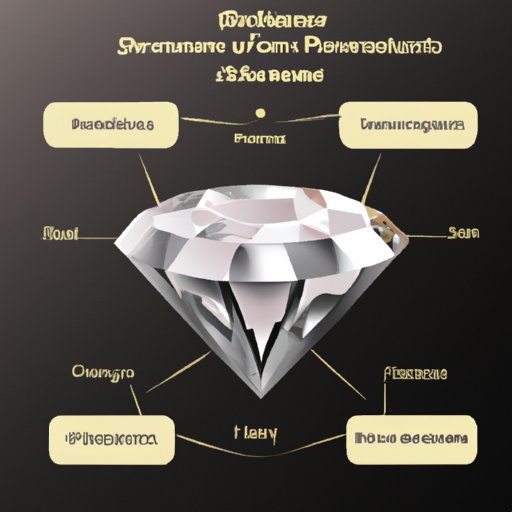Introduction
Diamonds are known for their beauty and brilliance, but few people know the complex process by which they are formed. In this article, we will explore the journey of a diamond from its formation to its eventual sale, focusing on the geological process, mining and extraction, life cycle, and economic value.

Describing the Geological Process of Diamond Formation
The process of diamond formation begins deep within the Earth’s mantle, around 100 miles below the surface. Here, high temperatures and pressures combine to form a unique environment that allows diamonds to form over millions of years. In this environment, carbon-rich fluids mix with other elements to form the diamond’s crystal structure.
The diamond eventually makes its way to the surface through volcanic activity. This process can take up to 3 billion years, and during this time the diamond is subjected to extreme heat and pressure that further shapes its structure. After reaching the surface, the diamond is found in alluvial deposits or kimberlite pipes, where it can be mined and extracted.

Explaining How Diamonds are Mined and Extracted
Once diamonds are found, they must be mined and extracted from the earth. This process typically involves excavating large amounts of soil and rock to expose the diamond deposits. Once exposed, the diamonds are collected and sorted according to their size and quality. The diamonds are then transported to a processing facility where they are cut and polished.
Depending on the type of diamond being mined, different techniques may be used. For example, open-pit mining is used to extract diamonds from shallow deposits, while underground mining is used to access deeper deposits. Another method, called marine mining, is used to extract diamonds from the seabed. This technique uses specialized equipment to collect diamonds from the ocean floor.
Discussing the Life Cycle of a Diamond from Formation to Sale
Once a diamond has been mined and processed, it enters the next stage of its life cycle: the retail market. Here, the diamond is graded and given a certification that verifies its quality and authenticity. The diamond is then sold to retailers, who in turn sell it to consumers. The final stage of the diamond’s life cycle is when it is purchased by a customer.
At each stage of the diamond’s life cycle, it is subject to a variety of treatments and processes. For example, diamonds may be cut, polished, and treated with chemicals or lasers to enhance their appearance. These treatments can add value to the diamond, making it more desirable to buyers.
Analyzing the Role of Carbon in Diamond Formation
Carbon plays a pivotal role in the formation of diamonds. It is the primary element that makes up a diamond’s crystal structure, and it is also responsible for the diamond’s hardness, strength, and durability. Without carbon, diamonds would not exist.
The amount of carbon present in a diamond is determined by the environment in which it was formed. For example, diamonds formed in high-pressure environments tend to have more carbon than those formed in low-pressure environments. This is why some diamonds are harder and more valuable than others.
Comparing and Contrasting Different Types of Diamonds
Not all diamonds are created equal. There are several types of diamonds, each with its own characteristics and properties. The most common types of diamonds are white, yellow, pink, blue, and black. Each type has its own unique color, clarity, and hardness.
White diamonds are the most common and sought-after type. They are characterized by their clear and bright appearance. Yellow diamonds, on the other hand, are less common and have a warm, golden hue. Pink diamonds are rare and have a soft, romantic feel, while blue diamonds are even rarer and often have a mysterious quality. Black diamonds, the rarest type, are opaque and have a striking appearance.

Examining the Value of Diamonds from an Economic Perspective
The value of diamonds differs greatly depending on their quality and rarity. Generally, the more rare and higher quality a diamond is, the more valuable it is. Factors such as carat size, cut, color, and clarity all affect a diamond’s value.
In addition to quality and rarity, diamonds can also be valued based on their historical significance. For example, some diamonds may have been owned by famous people or come from important mines. These factors can add to the overall value of a diamond, making it more desirable and expensive.
Conclusion
In conclusion, diamonds are incredibly complex objects that require millions of years and extreme conditions to form. From their formation to their eventual sale, diamonds go through a long and complex process that involves mining, extraction, and various treatments. Understanding the process of how a diamond is formed can help us appreciate their beauty and value even more.
Knowing how a diamond is formed also helps us understand the complexities of the diamond industry and the factors that determine a diamond’s value. By learning about the process, we can make more informed decisions when buying diamonds, ensuring that we get the best value for our money.


